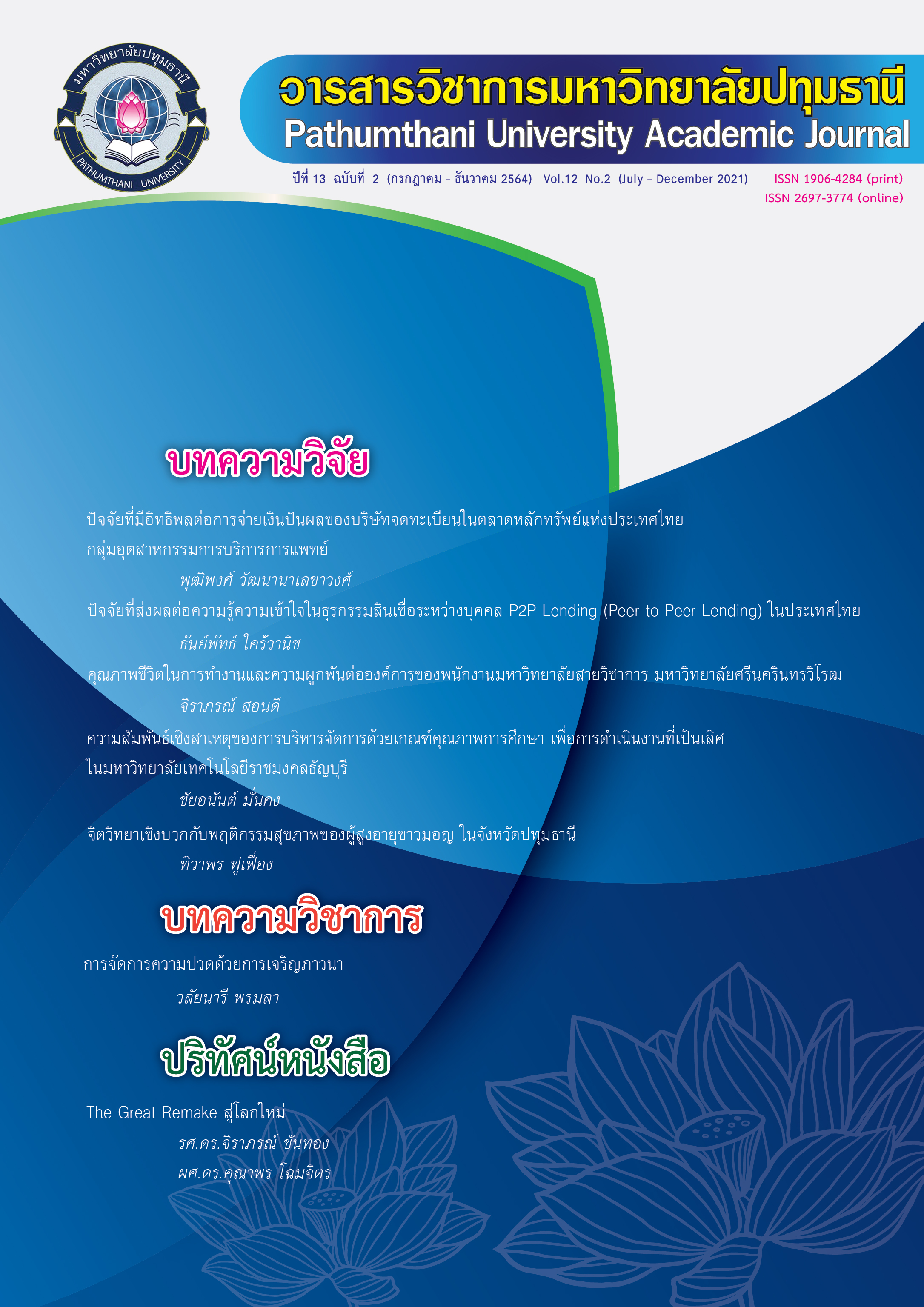CAUSAL RELATIONSHIP OF MANAGEMENT WITH EDUCATIONAL CRITERIA FOR PERFORMANCE EXCELLENCE IN THE RAJAMANGALA UNIVERSITY OF TECHNOLOGY THANYABURI
Keywords:
Loose Part Play, Activity Basic Mathematical Skills in Number Sense, Young ChildrenAbstract
The study of the causal relationship of management with educational criteria for performance excellence at the Rajamangala University of Technology Thanyaburi aims to: 1) study causal factors of management with educational criteria for performance excellence at the Rajamangala University of Technology Thanyaburi, 2) develop a causal relationship model of management with educational criteria for performance excellence at the Rajamangala University of Technology Thanyaburi, and 3) examine consistency of a causal relationship model of management with educational criteria for performance excellence at the Rajamangala University of Technology Thanyaburi. A sample of 350 lecturers and administrators were randomly selected from five pilot faculties that have implemented educational criteria for performance excellence at the Rajamangala University of Technology Thanyaburi under Ministry of Higher Education, Science, Research and Innovation in the 2020 academic year. The instrumentation used in the study, there was a questionnaire adapted by the researcher. The data analysis used descriptive statistics in terms of relationship coefficient, Skewness: Sk, Kurtosis: Ku, along with confirmatory factor analysis (CFA), Pearson’s Correlation Coefficient and structural equation modeling (SEM).
The results of the study showed that: 1) the causal relationship of management with educational criteria for performance excellence at the Rajamangala University of Technology Thanyaburi is consisted with organizational leadership, customers, measurement, analysis, and knowledge management, workforce, strategy, operations and results; 2) the model of the causal relationship of management with educational criteria for performance excellence at the Rajamangala University of Technology Thanyaburi included organizational leadership, customers, measurement, analysis, the knowledge management and workforce which were independent variable, the strategy and operations were mediating variables and the outcomes were dependent variables. 3) the developing model has become organizational leadership variables, customer variables, measurement variables, analysis and knowledge management variables and workforce, there were an exogenous latent variable that indirectly linked with the performance result variable as represented by using the strategy variables and operating variables which were an endogenous latent variables that transmitted the relations between the organizational leadership variables, customer variables, measurement, analysis and knowledge management variables and workforce variables to the result variables that the model is consistent to empirically data as the statistic (X2/df) = 2.80, IFI = .97, NFI = .96, TLI = .96, CFI = .97, GFI = .87 และ RMSEA = .07
References
กริซ แรงสูงเนิน. (2554). การวิเคราะห์ปัจจัยด้วย SPSS และ AMOS เพื่อการวิจัย. กรุงเทพมหานคร : โรงพิมพ์บริษัท วี.พริ้นท์ (1991) จำกัด.
กองบริหารงานบุคคล มหาวิทยาลัยเทคโนโลยีราชมงคลธัญบุรี. (2564). ข้อมูลจำนวนบุคลากร.[ออนไลน์]. เข้าถึงได้จาก https://www.ped.rmutt.ac.th/?p=8255 เมื่อวันที่ 16 มกราคม 2564.
ธเนศน์ นุ่นมัน. (2561). วิกฤติมหา’ลัย โจทย์ใหญ่ที่ต้องเร่งปรับตัว. [ออนไลน์]. เข้าถึงได้จาก https://www.posttoday.com/politic/report/546661 เมื่อวันที่ 4 เมษายน 2561.
วรรณภา ตันทิวากร. วารสาร Mahidol R2R e-Journal. [ออนไลน์]. เข้าถึงได้จาก http://doi.org/10.14456/jmu.2017.28 น.160-181. เมื่อวันที่ 16 มกราคม 2564.
สุวัฒน์ งามดี และปิยพร มานะกิจ. (2560). การวิเคราะห์ปัจจัยที่มีผลต่อความสำเร็จตัวชี้วัดของแผนกลยุทธ์ ตามเกณฑ์ EdPEx กรณีศึกษา : คณะเภสัชศาสตร์มหาวิทยาลัยเชียงใหม่ [ออนไลน์]. เข้าถึงได้จาก https://www.pharmacy.cmu.ac.th/unit/unit_files/files_data/2018-06-08Full%202559.pdf เมื่อวันที่ 16 มกราคม 2564.
สำนักงานปลัดกระทรวงการอุดมศึกษา วิทยาศาสตร์วิจัย และนวัตกรรม. (2563). เกณฑ์คุณภาพการศึกษาเพื่อการดำเนินการที่เป็นเลิศ ฉบับปี 2563 – 2566. [ออนไลน์]. เข้าถึงได้จาก http://www.edpex.org/2020/11/edpex-2563-2566.html เมื่อวันที่ 16 มกราคม 2564.
สำนักงานเลขาธิการสภาการศึกษา. (2560). แผนการศึกษาแห่งชาติ พ.ศ. 2560 – 2579. เข้าถึงได้จาก http://backoffice.onec.go.th/uploads/Book/1540-file.pdf เมื่อวันที่ 4 เมษายน 2562.
Anderson, R.E. (2010). Multivariate Data Analysis: A Global Perspective. (7th ed). Upper Saddle River, NJ: Prentice Hall.
Hair, J.F., W.C. Black, W.C. Babin and R.L. Tatham. (2006). Mulitivariate data analysis. (6th ed). New Jersey: Prentice Hall.
Hair, J.F., Black, W.C., Babin, B.J. & Anderson, R.E. (2010). Multivariate Data Analysis. (7th ed.). Pearson: New York.
Hooper, D., Coughlan, J. & Mullen, M. R. (2008). “Structural equation modeling: guidelines for determining model fit”. Journal of Business Research. Vol 6 No. 1. pp 53-60.
Jayamaha, Nihal P., Nigel P. Grigg, Robin S. Mann. (2008). "Empirical validity of Baldrige criteria: New Zealand evidence" International Journal of Quality & Reliability Management, Vol. 25 No. 5. pp. 477–493
Joreskog, K. & Sorbom, D. (1993). LISREL 8: Structural equation modeling with the SIMPLIS command language. Chicago, IL: Scientific Software International Inc.
Khampirat, Buratin. (2009). “Application of Baldrige Education Criteria on the Assessment of an Autonomous University in Thailand” European Conference on Educational Research (ECER), September, 2009.
Menezes, P. H. B., Martins, H. C., & Oliveira, R. R. (2018). The Excellence Baldrige Criteria in The Effectiveness of Higher Education Institutions Management. Brazilian Business Review. Vol 15 No. 1. Pp 47–67.
Nader S. Santarisi and Amal H. Tarazi. (2008). “The Effect of TQM Practices on Higher Education Performance: The Faculty of Engineering and Technology at the University of Jordan as a Case Study” Dirasat, Engineering Sciences. Vol 35 No. 2, pp. 84 – 96
Sahney, S., Banwet, D.K. and Karunes, S. (2008). “An integrated framework of indices for quality management in education: a faculty perspective” The TQM Magazine. Vol. 20 pp. 502 – 519.
Suri, R K, S Amin. (2013). “Leadership, Becpem and The Route to Quality Management in Private Management Institutes with Specific Reference to DELHI - NCR”. Asian Journal of Research in Business Economics and Management. Vol. 3, Issue 5 pp. 29 – 61
Uyu Wahyudin, Ridwan El Hariri and Deni Darmawan. (2013). “Developing Image of Higher Education Performance”. Scientific Research. Vol 6 No. 4 pp. 407 – 413
Downloads
Published
How to Cite
Issue
Section
License
บทความที่ได้รับการตีพิมพ์เป็นลิขสิทธิ์ของวารสารมหาวิทยาลัยปทุมธานี
ข้อความที่ปรากฎในบทความแต่ละเรื่อง เป็นความคิดเห็นส่วนตัวของผู้เขียน กองบรรณาธิการไม่จำเป็นต้องเห็นด้วยเสมอไป และไม่มีส่วนรับผิดชอบใด ๆ ถือเป็นความรับผิดชอบของผู้เขียนแต่เพียงผู้เดียว



